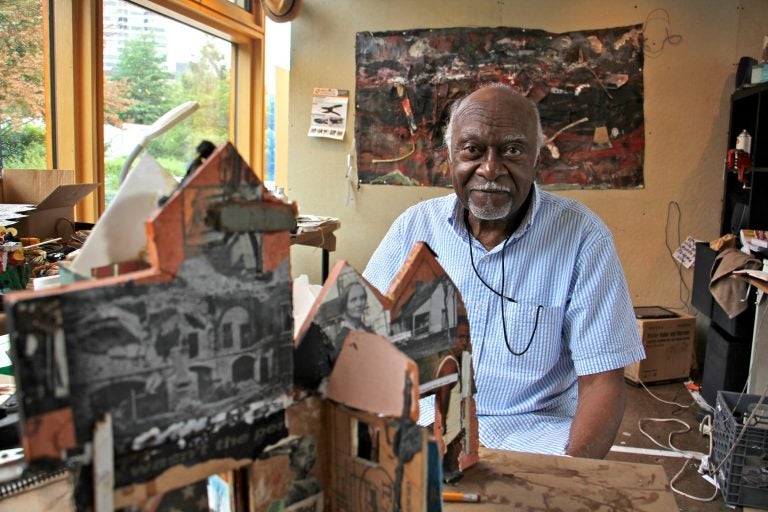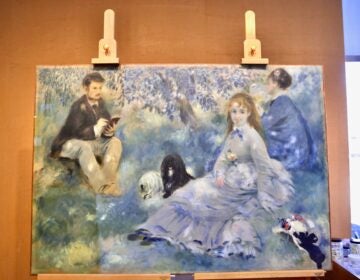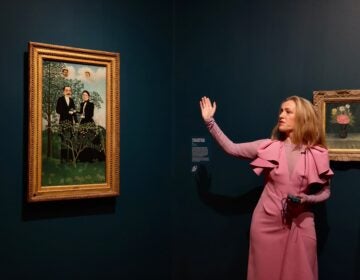‘Activist artist’ Leroy Johnson working inside the Barnes fishbowl
Leroy Johnson is making a mess at the Barnes Foundation. You can watch him work.
Listen 2:22
Leroy Johnson is the artist-in-residence at The Barnes. (Emma Lee/WHYY)
Leroy Johnson starts each day with a cup of coffee and “Morning Joe.” The caffeine turns over his engine. The cable news pundits rev his ire.
“It fuels my work,” he said. “I’m an activist artist.”
Johnson is sitting in the glasshouse that used to be the Barnes Foundation’s ticketing office. It’s a detached building next to the galleries on the Parkway, in plain view of pedestrians on 20th Street. For the past year, the Barnes, along with Mural Arts Philadelphia, has selected artists to be in residence in the public-facing studio on the sidewalk.
Johnson is the last and most prominent artist on the roster. For the rest of the summer, he will be in what he calls “the fishbowl” working on paintings and sculpture related to the Civil War.
“What I’m trying to do is have people understand the connection between now and what occurred in the past,” he said. “How can the party of Lincoln have somebody stand up there saying, ‘Go back to where you came from.’”
He’s referring to the taunt President Trump tweeted at four members of Congress last week. He is not a fan of the president. “I thought we were still trying to form a more perfect union,” he said.
Johnson, 82, has been making art in Philadelphia for more than six decades and does not seem to be slowing down. He can draw, paint, sculpt, weld, throw clay, and blow glass. He is largely self-taught, with an informal arts education bolstered by time spent at Fleisher Art Memorial, the Philadelphia College of Art (now the University of the Arts) and the Clay Studio.
He mostly works in assemblage, pulling together bits and pieces of seemly random things into a single work: cardboard, metal, scraps of fabric, even an old watchband. He hauls over boxes of stuff from his studio in Callowhill to the Barnes studio. It’s littered with what passersby might easily mistake as trash.
“I was fortunate enough to grow up with my own bedroom,” said Johnson, who grew up in the 1940s in Eastwick, a South Philadelphia neighborhood near the airport. “It was far messier than this. I always had books all over, painting stuff, and science equipment. My room was always a mess. That’s how I am.“
Every scrap means something. He doesn’t glue anything to the canvas unless he feels it.
“Freud said, if in anger or in an emotion you did something like this…” said Johnson, wadding up a piece of paper and throwing it to the floor. “Bam! You just objectified a subconscious feeling. You’ve made it conscious and you can deal with it.”
The paintings Johnson is working on while in residency each depict a specific battle of the Civil War, but not that you could recognize it. He’s not interested in troop movements or war heroes, but the messy, visceral violence of the battlefield. The works are abstract, layered with color and objects that communicate a texture of destruction.
“This is the Battle of Antietam,” said Johnson, pointing to a large, loose canvas roughly torn into a rectangle, pinned to the wall. Antietam is considered one of the worst bloodbaths of the Civil War. More than 20,000 soldiers were killed or wounded in the one-day battle.
Johnsons is trying to do for Antietam what Pablo Picasso did for the bombing of Guernica during the Spanish Civil War. “No painting ever depicted the horrors of the battles,” he said.
The artist residency program at the Barnes came out of last year’s “Let’s Connect” initiative when the foundation held an open-call exhibition of works by regional artists. Three hundred works were displayed and voted upon by the public. Four artists were chosen for three-month residencies.
“The public picked an amazing range of artists that do intense realism,” said Kathleen Greene, Barnes’ curator of public programs. They include a printer, an illustrator, a reverse-glass painter, and an oil portraitist.
“They were all hyper-realistic,” said Greene. “Leroy is not at all.”
Johnson draws on the legacy of African American vernacular artists such as Horace Pippin and Jacob Lawrence, but with a more expressive hand. He makes urban folk art. The odd man out in a small class of realists, Johnson is designated the Barnes’ “Director’s Highlight.”
“I think of Leroy as being a constant heartbeat within the Philadelphia artistic scene,” said Greene. “He’s cyclical in that he’s always present, always working, and always relevant.”
Along with the paintings, Johnson is working on small sculptures of houses, inlaid with imagery of African Americans of the Civil War and Reconstruction era. It’s connecting the conditions under Jim Crow laws with contemporary urban gentrification.
“I want history to see me as an artist who had something to say, and saying it in an elegant way,” he said. “Like Thelonious Monk, playing my own notes.”
Although an avid fan of jazz, Johnson doesn’t listen to it while he works. Instead, he prefers non-musical sonic pulses and tones, theta and alpha waves, often used in meditation practices.
“I prefer pure sounds. I feel like they are healthier,” he said. “If you watch ‘Morning Joe,’ you need something to counteract that stuff. ‘Morning Joe’ can get my eyes crossed sometimes.”
WHYY is your source for fact-based, in-depth journalism and information. As a nonprofit organization, we rely on financial support from readers like you. Please give today.





